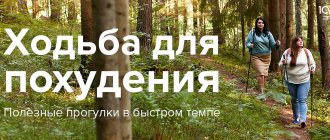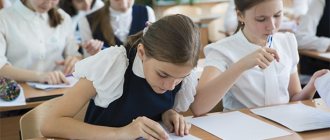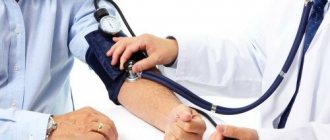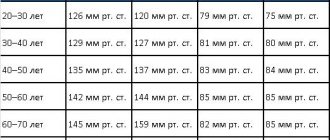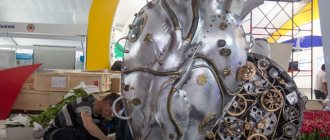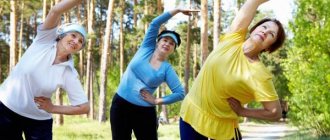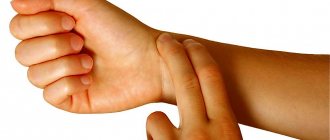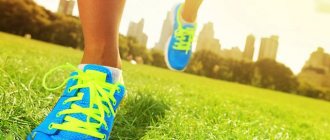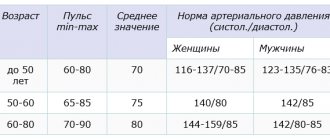If you train remotely or attend in-person classes, you've probably noticed that your instructor repeatedly asks you to take your heart rate during training. Let's figure out how to do it correctly and why it's done.
| Pulse (pulse wave) is a heartbeat that spreads along the walls of blood vessels. Normally, heart rate (heart rate) is equal to the pulse and at rest is 60-90 beats per minute. |
It is more convenient to measure the pulse in places where the walls of the arteries are located close to the skin:
- carotid artery (during training we count the pulse using it);
- radial artery (the doctor usually measures the pulse there);
- temporal artery;
- inguinal artery.
Heart rate[edit | edit code]
Source:
Sports Encyclopedia of Life Support Systems. Editor
: Zhukov A.D.
Ed.
: Unesco, 2011.
The average resting heart rate is 60-80 beats per minute and can sometimes exceed 100 beats per minute in sedentary middle-aged people. It is known that trained endurance athletes who are in good shape have a minimum resting heart rate of 28-40 beats per minute.
Rice. 4. Heart rate increases in proportion to the increase in load on the bicycle ergometer, ultimately reaching the maximum value (HRmax). In untrained people it increases faster than in well-trained people. In a trained person, the linear increase with increasing load looks more obvious
Before physical activity begins, your heart rate usually increases, well above normal resting levels. As mentioned above, this anticipatory response is likely due to the release of the neurotransmitter norepinephrine by the sympathetic nervous system and the hormone adrenaline by the adrenal glands. The tone of the vagus nerve may also be reduced.
The increase in heart rate is almost proportional to the increase in exercise intensity and oxygen consumption until complete exhaustion (Fig. 4). The less trained a person is, the higher the heart rate. An increase in heart rate during physical activity is caused by a decrease in vagal tone and an increase in sympathetic stimulation of the heart. It must also be remembered that the psychogenic increase in heart rate can be significant.
Starting from the age of 10-15 years, the maximum heart rate begins to decrease slightly but steadily - by about 1 beat per year. This is a very reliable value that remains unchanged from day to day. In adults, maximum heart rate can be calculated as follows:
Heart rate max = 220 minus age in years
At a constant level of submaximal exercise, the heart rate increases and then levels off as the oxygen demand for that activity has been met. With each subsequent increase in intensity, the heart rate will reach a new steady-state value within 1-2 minutes. However, the more intense the physical activity, the longer it takes to achieve this steady-state value.
The concept of steady-state heart rate provides the basis for several tests designed to assess physical fitness. In these tests, people are placed on a machine, such as a bicycle ergometer or treadmill, and exercised at standard levels of exercise. Those who are more physically fit, as measured by their cardiorespiratory endurance, will have a lower steady-state heart rate at a given level of exercise than less fit individuals.
During prolonged exercise, instead of leveling off, your heart rate may continue to increase steadily at the same level of exercise. This phenomenon is called cardiovascular shift, which is caused by a decrease in venous return to the heart. The heart rate continues to increase to keep cardiac output (cardiac output) and blood pressure at the same level, despite the decrease in venous return. Venous return can be reduced by a reduction in plasma volume caused by the filtration of fluid from the blood or excessive sweating during prolonged exercise. Decreased sympathetic tone may also play a role in reducing venous return to the heart.
During strength exercise, such as weight lifting, your heart rate is lower than during endurance exercise, such as running. With the same effort produced during physical activity on the upper body, the heart rate is higher than during exercise on the lower body. Upper body exercise also results in higher oxygen consumption, mean arterial pressure, and total peripheral vascular resistance. The higher circulatory load of upper body training results from less muscle mass, increased intrathoracic pressure, and less efficiency of the “muscle pump,” all of which reduce venous return of blood to the heart.
Heart rate multiplied by systolic blood pressure gives the heart rate-pressure product (HRP), which allows you to estimate the load on the heart during exercise:
PP - heart rate x systolic blood pressure.
Physical education tests
OPTION
II
1.
Physical education is
...
A. A lesson during which physical exercises are performed.
b. Education of physical qualities and training in motor actions.
V. Part of human culture.
d. The result of improving people's abilities.
2.
Physical culture is focused on improving
...
A. Motor actions.
b. Natural physical properties of man.
V. Physical and volitional qualities of people.
d. Human performance.
3.
A distinctive feature of physical culture is
...
A. The process of developing physical qualities.
b. Physical development of people.
V. Learning motor actions. d. Doing physical exercises.
4.
Physical development means
…
A. A set of indicators such as height, weight, chest circumference, vital capacity, dynamometry.
b. A level determined by heredity and regularity of physical education and sports.
V. The process of changing the morpho-functional properties of an organism throughout an individual’s life.
d. Characteristics of muscle strength, speed, endurance, flexibility, coordination.
5.
Physical fitness, acquired in the process activities, is characterized by ...
A. Level of performance and versatility of motor experience.
b. Resistance to the process of fatigue and the effects of various unfavorable factors.
c. High results in educational, labor and sports activities.
d.Good development of respiratory and circulatory systems, sufficient margin of reliability, efficiency and economy.
6.
Physical exercise is called
…
A. Forms of motor actions that increase human performance.
b. Movements performed in physical education lessons and during morning exercises.
V. Combinations of motor actions that contribute to solving the problems of physical education.
d. Motor actions, dosed according to the amount of load and duration of execution.
7.
The load of physical exercise is characterized
…
A. The magnitude of their impact on the body.
b.The purpose of the lesson.
V. How you feel during class.
d. Time and number of repetitions of motor actions.
8.
The amount of physical exercise load is determined by
...
A. The duration of motor actions.
b. A combination of volume and intensity of motor actions.
V. The number of repetitions of motor actions.
d. Intensity of motor actions.
9.
If after performing the exercises, the heart rate is restored within 30 seconds to the level that was at the beginning of the lesson, then this indicates that the load
...
A. It is tolerated relatively easily by the body.
b. It is small and should be enlarged.
V. Quite large, but it can be repeated.
d. Excessive and needs to be reduced.
10.
The intensity of exercise can be determined heart Moderate intensity causes the heart rate to increase to ...
a. 120-130 beats per minute.
b. 130-140 beats per minute.
V. 140-150 beats per minute.
150 or more beats per minute.
11.
Regular physical exercise helps
...
A. A person who exercises gets tired more slowly and recovers faster.
b. During classes, motor actions are performed to help develop strength and endurance.
V. A person who engages in physical exercise is able to perform a greater amount of physical work in the allotted period of time.
d. The fatigue achieved in this case activates the processes of recovery and adaptation to increasing loads.
12.
First aid for hitting a hard surface and causing bruises is that the bruised should be... a
. Cool.
b. Heat.
V. Cover with iodine mesh.
d. Rub, massage.
13.
Hardening means
…
A. Swimming in cold water and walking barefoot.
b. Using the healing powers of nature and hygienic factors.
c. Adaptation of the body to environmental influences.
d. Combination of air and sun baths with exercises.
14.
Which of the following recommendations should not be followed when organizing classes with hardening procedures?
A. The lower the air temperature, the more intensively you need to perform the exercises, since hypothermia must not be allowed.
b. It is not recommended to exercise in intense sunlight.
c. After class you need to take a cold shower.
d. The higher the air temperature, the shorter the classes should be, since overheating of the body should not be allowed.
15.
Hardening procedures are not recommended
a. Right after school.
b. Before doing homework.
V. Before meals. d. Before bed.
16.
Correct breathing is characterized by...
a. Inhale through the nose and exhale through the mouth.
b. Inhale longer. c. Longer exhalation.
d. The ratio of the duration of inhalation and exhalation does not matter.
17.
When performing exercises, inhalation should not be done during ... a
. Bending the body back.
b. Crossing arms and turning the body.
V. Returning to the starting position after turning or rotating the body.
d. Recommendations regarding the timing of inhalation or exhalation are not necessary.
18.
It's called posture
…
A. The usual posture of a person in an upright position.
b.Spring characteristics of the spine and feet.
V. No disorders of the spine or feet.
d. Shape of the spine.
19.
Signs that are not characteristic of correct posture:
a. A straight line can be drawn through the ear, shoulder, hip joint and ankle.
b. Raised chest.
V. Shoulders back, straight back. d.3 tilted or lowered head.
20.
Your posture can be considered correct if you, standing near a wall, touch it
...
A. The back of the head, lower back, buttocks, heels.
b.Back of the head, shoulder blades, buttocks, heels.
V. Back of the head, back, heels.
g. Shoulder blades, buttocks, heels.
21.
The main cause of poor posture is
…
A. Carrying a bag or briefcase in one hand.
b. Soft bed with high pillow.
V. Design of school tables. d. Muscle weakness.
22.
When Russian athletes first participated
in
the Olympic Games, there were only 5 of them. Nevertheless , figure skater Nikolai Panin-Kolomenkin managed to become an Olympic champion.
This happened in a. 1904 at the III Olympic Games in St. Louis.
b. 1912 at the V Olympic Games in Stockholm. V. 1908 at the IV Olympic Games in London.
1924 at the 1st Winter Olympic Games in Chamonix.
23.
The term "Olympics" means
…
A. Year of the Olympic Games.
b. Four-year period between Olympic Games.
V. A meeting of athletes in one city.
g. Synonymous with the Olympic Games.
24.
Vladimir Kuts, Valery Borzov, Viktor Saneev, Valery
...
A. Athletics.
b. Swimming.
V. Wrestling and boxing.
Hockey.
25. In what year were the Olympic Games held in our country?
A. In 1984, the XXIII Olympic Games were held in St. Petersburg.
b. In 1980, the XXII Olympic Games were held in Moscow.
V. The Olympic Games were planned to be held in 1944, but they were canceled due to World War II.
d. The Olympic Games have not yet been held in our country.
26.
Following a daily routine helps improve health
...
A. The main tasks are distributed evenly throughout the day.
b. Allows you to properly plan things during the day.
V. Allows you to avoid unnecessary physical stress.
d. Determines the rhythm of the body's work.
27.
Replacing some types of activities with others, regulated by the daily routine, allows you to maintain performance
...
A. It has a positive effect on a person’s physical and mental state.
b.Rhythmic alternation of work and rest prevents the occurrence of overstrain.
V. Relieves fatigue of nerve cells in the brain and dulls the feeling of general fatigue
d. The daily routine does not involve replacing one type of activity with another.
28.
Systematic and well-organized physical exercise improves health because
...
A. Allows a person to work more fruitfully and lead an active lifestyle.
b. The heart increases in volume and works more efficiently.
V. Provides nutrients to the body's organs.
d.Help increase the body's reserve capabilities.
29.
In what sequence should the exercises listed hygienic gymnastics?
- Run at a relaxed pace.
- Running with transition to walking.
- Walking with a gradual increase in
step frequency. - Jumping.
- Exercises to strengthen muscles and increase
flexibility. - Alternately tensing and relaxing muscles
- Sipping..
8.
Breathing exercises.
A. 1,2, 3,4, 5, 6, 7, 8.
b. 7,6,3, 1,8,5,4,2,8.
V. 8, 3,4, 5, 6, 7, 1,2,8.
g. 3,7, 5, 4, 1,6,8,2.
30.
In physical education lessons there are preparatory ...
A. The Academy of Pedagogical Sciences requires the selection of parts in a lesson.
b. This makes it more convenient for the teacher to distribute exercises of different nature.
V. It is necessary to control the dynamics of the performance of those involved.
d. It is more convenient to cultivate physical qualities in the preparatory part, to master the technique in the main part, and it is better to ensure the restoration of the body in the final part.
31.
What sequence of influences on physical qualities is most effective in the main part of the lesson on general physical training?
- For speed.
- For flexibility.
- For strength.
- For endurance.
A. 1,2, 3, 4.
6.2,3, 1,4
V. 3.2, 4, 1.
g. 4, 2,3, 1.
32.
Strength as a physical quality is understood as
…
A. A complex of muscle properties that creates great tension, allowing it to overcome resistance.
b. A complex of properties of the body that allows one to overcome external resistance or counteract it.
V. Properties of muscles due to which the ability to move large masses at a certain speed is realized.
d. A person’s ability to influence external forces due to muscle tension.
33.
A distinctive feature of the exercises used
...
A. The person's own weight is used as a burden.
b. They are performed until fatigue.
V. The weight of various sports equipment is used as a burden.
d. They cause significant muscle tension.
34.
When creating sets of exercises to reduce body weight using strength exercises, it is recommended
...
A. Use exercises with light weights and high repetitions.
b. Completely work one muscle group and only then move on to exercises that load another muscle group.
V. Locally influence individual muscle groups located closest to the areas of fat deposits.
d. Plan a large number of approaches and limit the number of repetitions in one approach.
35.
By speed as a physical quality we mean
a. A complex of human properties that allows one to quickly gain speed and move at high speed.
b. A complex of body properties that allows you to quickly respond to signals and perform movements with high frequency.
V. A complex of human properties that allows one to perform short work in a minimum period of time.
d. A complex of properties of the body that determine the speed of movement in space.
36.
In what sequence is it advisable to perform the exercises listed below to increase running speed
. Breathing exercises.
- Walking.
- Running in place at high frequency.
- Breathing exercises during rest
- Repeated short distance running.
- Easy long run.
- Jumping exercises
with and without weights.
A. 1.2, 3.4, 5, 6, 7
b. 7,5,4,3,2,6,1.
V. 2, 1,3,7,4,5,6. 3,5,4,7,6,2,1.
37.
To develop speed,…
a. Outdoor and sports games.
b. Strength exercises performed at a high tempo. V. Motor actions performed at maximum speed.
d. Exercises for reaction speed and frequency of movements.
38.
The best conditions for the development of reaction speed are created
...
A. Speed-strength exercises.
b. Outdoor and sports games.
V. Jumping up from a place.
d. Dribbling the ball with a “snake”.
39.
Flexibility as a physical quality means
a. A set of properties of the musculoskeletal system that determines the depth of inclination.
b. A set of properties of an organism that determine the mobility of its parts.
V. The ability to perform movements with a large amplitude due to muscle contractions.
d. The ability to perform movements with a large amplitude when using additional weights.
40.
To develop flexibility,…
a. Jerky movements.
b. Swing exercises with and without weights.
V. Active springing exercises. d. Movements performed with large amplitude.
41.
When cultivating flexibility, one should strive for
…
A. Increased mobility of the spine and elbow joints.
b. Achieving maximum range of motion in the main joints.
V. Harmoniously increasing mobility in the main joints.
d. Restoring the normal range of motion of the joints.
42.
How are “flexibility” exercises dosed, that is, how many movements should be done in one series? The exercises
...
A. Before pain appears.
b. Before sweat appears.
V. Until the range of motion begins to decrease.
d. 8-16 cycles of movements in a series.
43.
Endurance as a physical quality means
...
A. A complex of properties that makes it possible to perform a variety of physical activities.
b. Ability to perform a large amount of physical work and maintain specified work parameters.
V. The ability to perform physical work for a long time without getting tired.
d. A complex of body properties that determine the ability to resist fatigue.
44.
Human endurance does not depend on
…
A. Muscle strength.
b. Willpower.
V. Strength of the musculoskeletal system.
d. Capabilities of the respiratory and circulatory systems.
45.
Exercises used to develop endurance
...
A. Maximum range of motion.
b. High intensity.
V. Maximum activity of the respiratory and circulatory systems.
d. Active work of most body systems.
46.
When developing endurance, load The health regime causes an increase in heart
...
a.120 beats per minute.
b. 140 beats per minute.
V. 160 beats per minute.
160 or more beats per minute.
47.
Physical exercise technique is commonly called
…
A. Perfect forms of motor actions.
b. A method for expediently solving a motor problem.
V. Composition and sequence of movements when performing exercises.
d. Method of performing exercises.
48.
When analyzing technology, it is customary to identify the basis, leading The basis of technology is understood
...
A. A set of elements characterizing the individual characteristics of performing a holistic motor action.
b. The composition and sequence of elements included in a motor action.
V. A set of elements necessary to solve a motor task.
d. The most important part of a certain method of solving a motor task.
49.
In the process of learning motor actions, methods of integral or disjointed exercise The choice of method depends on
...
A. Possibilities of division of motor action.
b. An element without which the performance of a motor action is impossible.
V. Teacher's preferences. d. Complexities of the basic technology.
50.
It is recommended to begin the process of learning a motor action by mastering
…
A. Starting position.
b. Leading exercises. V. Leading technical link.
g. Fundamentals of technology.
You have completed the task. Congratulations!
1
The effect of physical activity on heart rate[edit | edit code]
“Methodological planning of a training program”
Scientific manual ed.
Professor L.P. Lysova, 2016 Heart rate during non-fatiguing and exhausting physical activity.
With non-fatiguing exercise, heart contractions reach a plateau phase; during exhausting exercise, there is a constant increase in heart rate. In addition to changes in breathing, with increasing load, changes also occur in the cardiovascular system and the heart rate, blood pressure and minute volume of blood circulation (cardiac output per minute) increase. When performing work that does not lead to fatigue, the heart rate reaches a plateau phase (steady state). During tiring or exhausting physical activity, this indicator does not reach a plateau, but demonstrates a constant increase in heart rate (which reflects accumulating fatigue) (Fig.).
The so-called parameters of the cardiovascular system increase in a linear relationship with the amount of physical activity, which makes it possible to assess the limits of the load in the studied individuals/patients. Using repeated measurements of parameters under submaximal load, an approximate line of maximum physical load (line of best fit) is constructed. An example of a submaximal load test is the PWC170 (Physical Working Capacity) test, which measures heart rate as the load is gradually increased until it approaches, but does not reach, 170 beats per minute. The normal PWC170 value for untrained men is 3.0 W/kg, and for untrained women 2.5 W/kg. In trained individuals, this value approaches 4 W/kg, which corresponds to the load power at which maximum oxygen consumption (VO2) is usually recorded.
